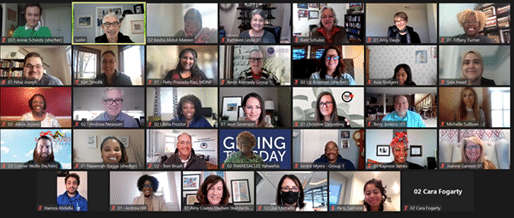

It’s been a week since the general election and there’s still a lot to take in. So much news in our 24/7 news cycle. I spoke with someone today who announced that she deliberately turned off all news outlets from November 2nd to November 9th. I was a bit taken aback by this statement. There are still quite a few lawn signs supporting candidates in the midst of the brightly colored fall leaves on the roads and byways in my community. What happens with everything that is left over after the campaign? What happens with the signs and brochures and t-shirts after the election is over? Perhaps the campaigns were able to distribute all of their candidate’s promotional materials BEFORE election day. But, perhaps not.
As I think about election-related swag, I recall an event from several years ago. I was on the board of a terrific all-volunteer nonprofit that collected new clothing and linens and distributed these items to different nonprofit organizations serving people in need throughout our metropolitan area. The organization held a fun event each year where groups of volunteers sorted the items, tagged them, and packed them up in huge boxes to send to local agencies. During one of these events, I remember receiving a large box of high-quality t-shirts that were leftover from a local candidate’s failed bid for a seat in the Maryland State Legislature. The t-shirts were cotton and soft, but they also clearly indicated the candidate’s name and political affiliation. Our tiny nonprofit knew that we had to remain nonpartisan to stay in good standing with the Internal Revenue Service, which prohibits political activity for public charities. The Standards for Excellence: An Ethics and Accountability Code for the Nonprofit Sector states that “In promoting public participation in community affairs, charitable nonprofits must be diligent in assuring they do not participate or intervene in any political campaign on behalf of or in opposition to any candidate for public office.”
It didn’t take us long to make the decision NOT to accept the t-shirts. We did not add them to our collection that day. I don’t know what ultimately happened to the leftover campaign shirts, but we felt that even though the candidate was no longer actively running for office, we wanted to stay far away from partisan politics to protect our tax exemption.
The organization had a gift acceptance policy that was primarily focused on the idea that donated clothing and linens needed to be new, not gently used, as per the organization’s mission. In hindsight, it seems we could have benefited from a more intentional, specific gift acceptance policy that might address other criteria for what gifts we would accept and what gifts we would decline. Now is a great time to take a look at your organization’s gift acceptance policy. In this post-election season, your gift acceptance policy, along with your advocacy policy, can help your nonprofit navigate decisions related to election-related gifts.
The Standards for Excellence educational resource packet, Fundraising, Solicitation, Acceptance of Gifts, and Working with Donors, contains a comprehensive gift acceptance policy that can be modified and customized to meet the needs of nonprofits around the country.
This educational resource packet and the full series of all packets – including sample policies, tools and model procedures to help nonprofits achieve best practices in their governance and management – can be accessed by contacting a Licensed Standards for Excellence replication partner, one of the over 150 Standards for Excellence Licensed Consultants, or by becoming a member of the Standards for Excellence Institute.



